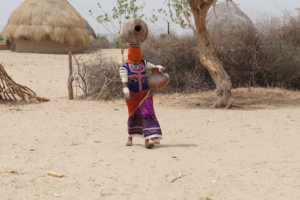🌿 Tharparkar: A Desert That Refuses to Die
Aejaz Ali Nohario
“Tharparkar is not just a desert. It is a land of life, colour and courage—where every drop of water is fought for, and every day is a test of endurance.”
📍 The Land Beyond Sand
Nestled in the southeastern edge of Sindh, Tharparkar is the largest district of the province, stretching across nearly 22,000 square kilometres. More than 1.65 million people call it home. From the bustling town of Mithi to the historic hills of Nangarparkar, life here is woven from centuries of resilience and tradition.
Yet beneath this rich heritage lies a stark truth: a water crisis that grows more severe with every passing year. With no flowing rivers, no major canals, and only a few erratic showers, the people of Thar have learned to depend on rainwater tanks, dug wells and hand pumps—most of which are now failing as the climate grows harsher.
💧 Every Drop is a Lifeline
In hundreds of villages, water is not a tap away—it is a journey. At dawn, mothers and daughters walk 2 to 4 kilometres carrying clay pots under a pitiless sun, just to fetch water that is often unsafe.
Because of this burden:
- Girls leave school to help carry water.
- Children fall sick with diarrhoea, typhoid, and skin infections.
- Men migrate to cities so their livestock don’t perish.
During droughts, families drive their herds far from home in search of pasture. Many survive for months on stored rainwater—shared between people and animals—spreading disease and despair.
Groundwater lies deep underground, sometimes 200 to 300 feet down. In recent years, technology has offered a glimmer of hope: boreholes and solar-powered pumps now help lift this precious resource to the surface. But countless communities still rely on traditional wells, donkeys, camels and sheer human effort.
🔥 Climate Change: The Invisible Enemy
Over the last 20 years, climate change has made life even harder.
Tharparkar faces:
- Prolonged droughts and disappearing rain
- Falling groundwater levels
- Relentless heatwaves
- Failed crops and vanishing grazing lands
These are not just natural disasters—they are a direct threat to survival.
🌱 The Spirit of Thar: Struggle and Hope
Yet the people of Thar are unbowed. Together with local NGOs and government agencies, communities have begun to fight back:
✅ Solar-powered pumps reduce women’s burden
✅ Rainwater harvesting tanks in schools and villages collect precious drops
✅ Health sessions spread awareness about hygiene
✅ Tree-planting drives slow desertification
But despite these efforts, hundreds of villages still wait for relief that never comes.
🚨 A Human Rights Crisis
The United Nations declares clean drinking water a fundamental human right. But in Tharparkar, this right remains a distant dream.
People here are not dying because they lack courage—they are dying because the world has not helped enough.
💡 What Must Be Done
A better future for Thar is possible—if we act now:
- Install solar sump pumps in every remote village
- Build small dams, canals and storage tanks
- Launch mobile health units for drought emergencies
- Expand climate education in schools
- Train young people in climate-smart farming
- Ensure fair distribution of resources
- Empower local communities to lead solutions
🌺 Conclusion: Let Thar Live
The people of Tharparkar are strong, proud and full of hope. But no one should have to fight every single day just to drink a cup of clean water.
This is not a story of pity—it is a call for justice.

